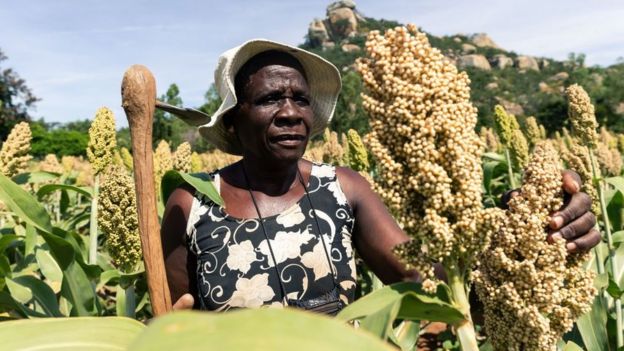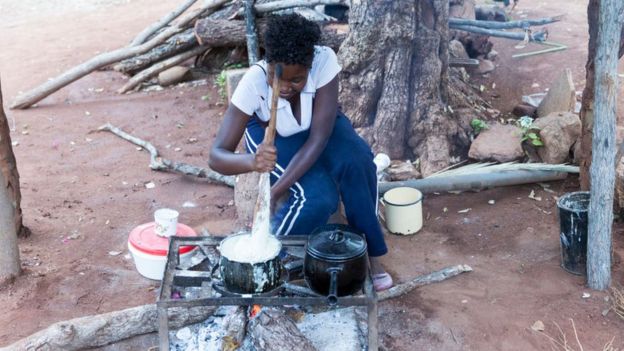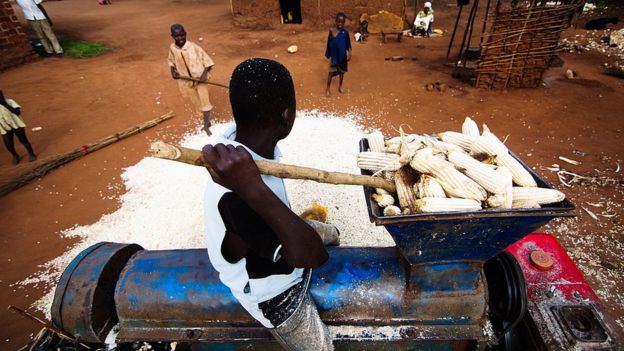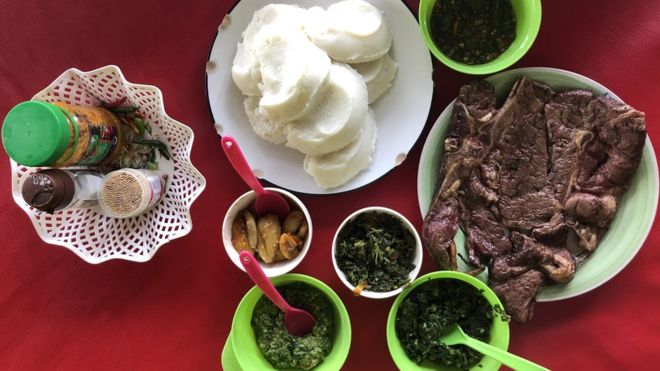Zambia's vice-president has called for a radical change in the eating habits of the nation, saying people should ditch the staple, maize meal, for more nutritious foods - a proposal akin to telling Italians to stop eating pasta.
Maize meal is hugely popular across much of southern and East Africa - research shows that sub-Saharan Africa consumes 21% of the maize produced in the world.
Zambian Vice-President Inonge Wina's appeal for a change in diet comes at a time when parts of her country and some neighbouring states have been hit by poor rainfall and food shortages - a recurring problem caused, in part, by climate change.
The crisis has led to 1.7 million Zambians - or 18% of the population - experiencing severe food insecurity, with about 40% of children under five years stunted, according to the UN-linked ReliefWeb information portal.
To tackle the problem, Ms Wina said people needed to vary their diet by eating more millet, sorghum, cassava, and sweet potatoes.
 Image copyrightGETTY IMAGES
Image copyrightGETTY IMAGES
"The gradual shift from predominantly maize-based meals is good for the nation as more nutritious foods will have space at our tables," she was quoted by the state-owned Daily Mail news site as saying.
"The switch to more nutritious foods is one of the low-cost and effective ways of addressing stunting and malnutrition in the country," Ms Wina said.
But she faces a formidable challenge to change eating habits.
Many people eat maize meal twice or three times a day. Some say they have not eaten unless they have had maize meal, which is known as nshima in Zambia, nsima in Malawi, sadza in Zimbabwe, papa or pap in South Africa and Lesotho, and ugali in Kenya.
Resistance to new dishes
The maize meal is boiled with water, and a bit of salt is added. It is then folded into the desired texture, making it a quick, cheap and easy dish.
It can also be fermented and served at breakfast as porridge, or cooked in a more dense form for lunch and dinner, when is it often served with meat, vegetable stews and sour milk.
 Image copyrightGETTY IMAGES
Image copyrightGETTY IMAGES
Clifford Chirwa, a fourth-year student at the University of Zambia, said he doubted the government would succeed in getting people to eat less of it.
"It's not possible because every culture has a specific food which is considered to be a staple. Just like you have jollof rice in Nigeria, nshima is typically Zambian," he told the BBC.
Agreeing with him, Olipa Lungu, who runs a restaurant at a busy market in the capital Lusaka, said her efforts to change the menu had failed.
"Nshima stands out. The only other food that people like are chips but even those I make only when there's a special order," she said.
Government subsidies
But Ms Wina's proposal has won the support of the Zambia National Farmers Union (ZNFU).
"With the advent of climate change, we have to start looking at various options of food. We have been too dependent on maize yet we grow crops such as sorghum, rice and millet," ZNFU spokesman Kakoma Kaleyi told the BBC.
"We rarely eat other foods. I think that our culinary tastes should change. This is the right call by the vice-president," he added.

Some nutritionists say the maize meal sold in supermarkets is highly processed and therefore lacks nutrients, vital for the health of our skin, hair and brain.
When eaten in its original form, maize contains nutrients such vitamin A, vitamin C, iron and fibre, but all the goodness is lost if it is over-processed, they say.
Maize meal is popular, especially in poor families, because it is often subsidised by governments, South African dietician Thandolwakhe Msomi told the BBC.
"So if you're looking at introducing other grains and have them become a staple in homes, we would need similar interventions by those in power," she added.

An nshima recipe for a family of five
Courtesy of the BBC's Kennedy Gondwe in Zambia
- Pour about two litres of water in a pot
- Let it almost boil
- Throw in five handfuls of maize meal
- Stir with a wooden spoon until the maize meal thoroughly mixes with the water
- Let it thicken; wait for the mixture to start bubbling
- Cook for close to 10 minutes on medium heat
- Then add another five handfuls of maize meal while continuously stirring
- At this stage, I prefer to sprinkle a bit of cassava meal to add a bit more nutrition and aroma
- When the mixture reaches its desired thickness, cover the pot and switch off the stove
- After about two minutes, scoop it out and enjoy
To go with: T-bone steak, beans and boiled okra

Unlike in many other countries, processed maize meal in South Africa is fortified with vitamins and minerals - all producers are legally required to add nutrients such as vitamin A and B to boost its health benefits.
"The more modern grain is steel-ground. It doesn't contain the germ of the kernel and that is where the nutrients are," Ms Msomi said.
"If we were to stone-mill the whole kernel we would get more energy-producing carbohydrates, protein and fibre, which isn't found even in fortified variants of the maize-meal," she said.

Yellow maize is also packed with more nutrients than white maize but "sadly we've been conditioned to believe that the yellow coarse kind is for the less affluent", the nutritionist added.
As for sorghum and pearl millet, Ms Msomi said they are "high-energy" grains which contain carbohydrates, protein, and are low in fat.
Furthermore, they are rich in vitamins A and B, high in calcium, iron and zinc, and also contain potassium, phosphorus, magnesium, copper, and manganese. Sorghum is also gluten-free.

What do vitamins and minerals do?
Vitamin A is vital for good eyesight
Vitamin B1 helps to release energy from carbohydrates
Vitamin C helps to prevent illness and make bones
Iron is needed to transport oxygen in the blood
Calcium strengthens bones and teeth
Zinc helps heal wounds

"At a time when we are focused on climate change and its effects on food security, these grains have been known to be hardy. They are able to withstand tougher climates," Ms Msomi said.
"People were educated about how to grow maize even in their homes. They can be educated about how to grow other grains too," she added.
Sorghum porridge anyone?
source: BBC



